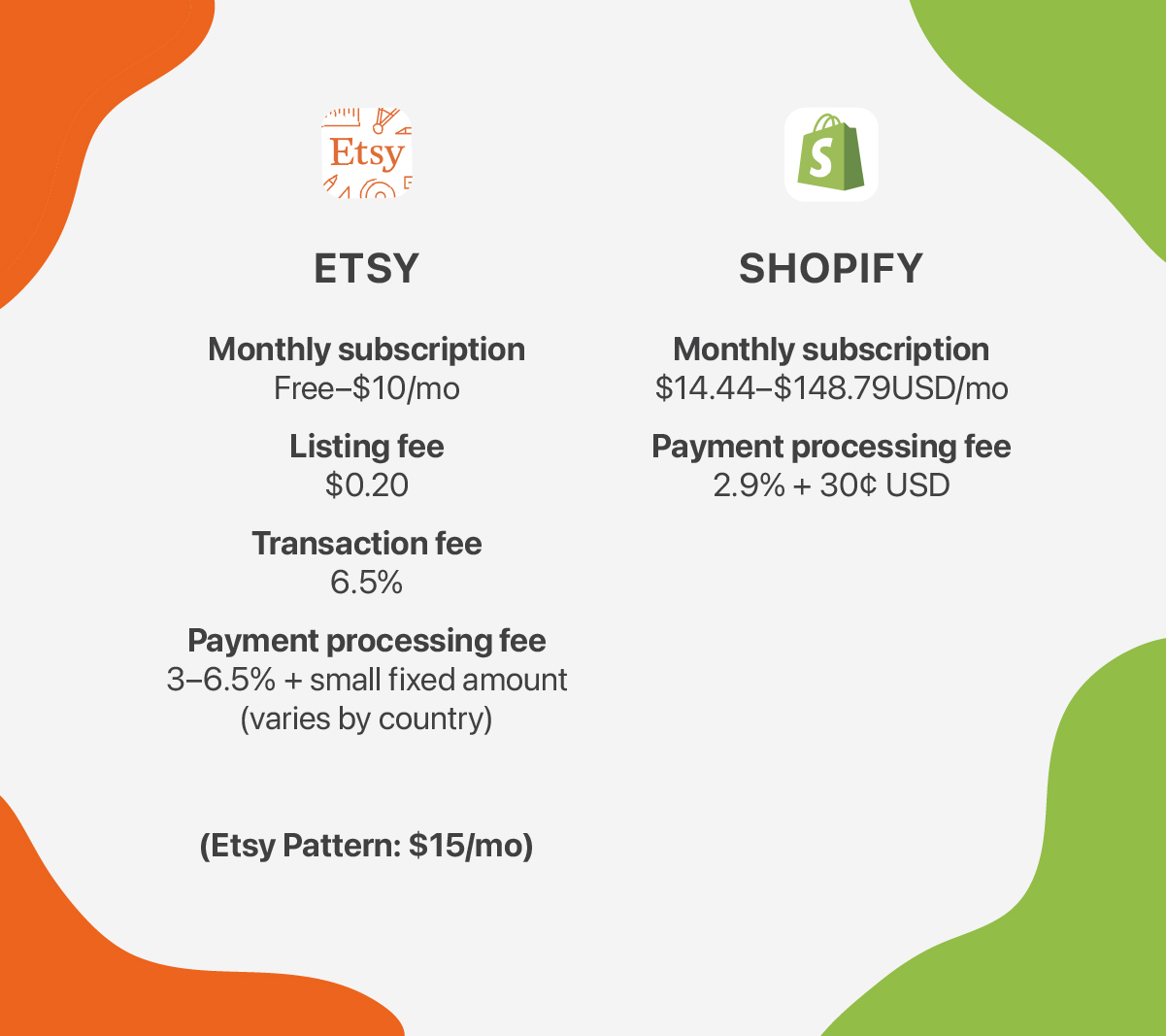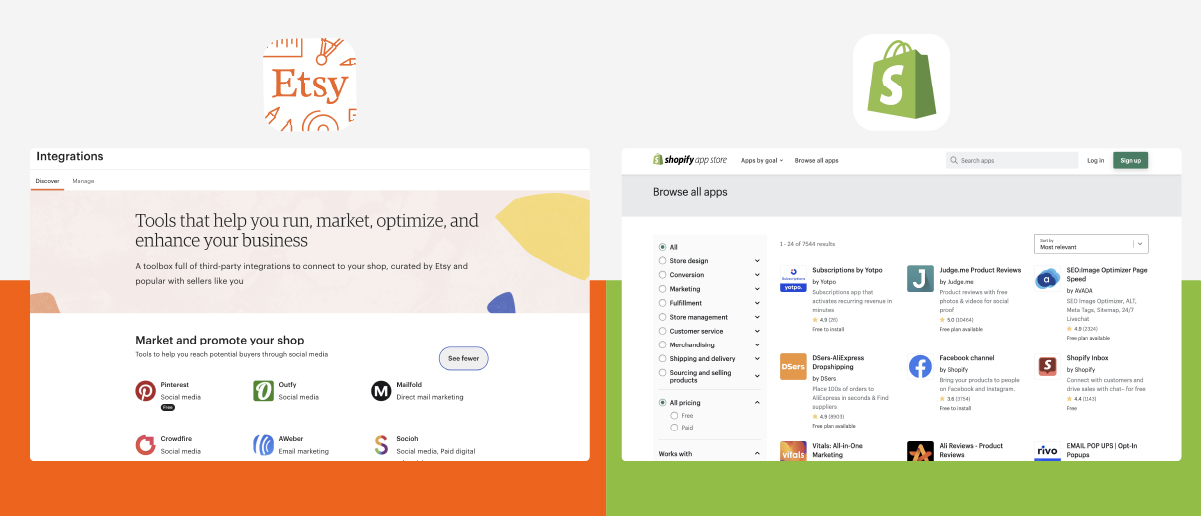.jpg)
For aspiring online sellers, setting up a store has never been easier. There are now a hundred different ecommerce platforms that allow you to build a fully branded site, complete with all the inventory tracking and customer engagement tools you might hope for.
Two of the standout names in this space are Shopify and Etsy. But which should you choose for hosting your virtual store?
To help you make an informed choice, we decided to make a head-to-head comparison between these giants of DIY ecommerce. Keep reading to discover which platform is the stronger overall, and which might be better suited to your retail ambitions.
Unless you are already familiar with the ecommerce business or you really enjoy buying homemade goods, you might not be super familiar with Shopify and Etsy. Let’s put that right:
Founded all the way back in 2006, Shopify is a platform that allows business owners to set up an online store with a limited budget and zero technical knowledge.
According to official numbers, over 1.7 million businesses around the world have a Shopify store. Meanwhile, stats from W3Tech show that 4.4% of the top 10 million websites on the Internet are hosted on Shopify. No wonder the platform posted a gross merchandise volume of $175.4 billion at the last count.
Built in just two-and-a-half months, Etsy was launched in 2005 as a more artisanal alternative to the likes of Amazon and eBay.
Like those big beasts, the site provides an online marketplace where sellers can reach potential buyers — no matter whether they are selling a single item or an entire catalog.
Where Etsy varies from the competition is when it comes to product selection. Everything sold on the site must be handmade, bespoke, vintage, or craft supplies.
In spite of this niche focus, Etsy played host to 7.5 million storefronts in 2021, with a customer base of 96.3 million, spending $13.5 billion on the platform.
Now we have met the competitors, it’s time for a direct showdown between these two rivals. Both have plenty to offer, but it’s time to find out which of these ecommerce heavyweights has what it takes to launch your online business.
The differences between Shopify and Etsy start becoming clear as soon as you begin setting up your account on each platform.
On Shopify, you first need to sign up for a subscription plan. (We will talk about pricing later). The platform then creates a standalone ecommerce website for you, linked to a free subdomain. In theory, you’re ready to go.

However, you will need to enter a variety of information to get your Shopify store ready for the real world. For instance, the platform asks you to input your tax details, add your address, and provide shipping information for future customers.
If you only stick to the absolute basics, you can probably get set up in about 15-30 minutes. For those happy to dive deeper, this platform offers a myriad of options to cover small businesses and large corporations alike — including dropshipping, POS, SEO, analytics, email marketing, and more.
In contrast, Etsy is much more focused on individual listings. In fact, when you create an account, the site actually takes you straight into listing your first product.

It’s worth noting that you don’t have to pay anything up front to start selling on Etsy. In part, this is because you’re simply joining a marketplace — not setting up your own ecommerce-focused website.
For this reason, Etsy is probably an easier place for new sellers to get started. More experienced sellers will also enjoy the relatively smooth workflow; the only downside is that you lose much of the control and functionality that is available in Shopify.
Along with a plentiful selection of backend settings, Shopify allows you to customize the appearance and branding of your store.
Entrepreneurs who are comfortable with code can build their storefront from the ground up; otherwise, Shopify offers a range of free and premium templates. In addition, you can brand your website with your own domain name.

Much like eBay, the Etsy marketplace allows sellers to create a kind of storefront where buyers can view all their listings in one spot. But this isn’t a place you can truly describe as your own website.
For that, you will need Etsy Pattern. This website builder allows you to craft your own site, in the same vein as Wix and Weebly.

Here you can add your branding, choose your fonts, select some colors, and add your own subdomain — and then all your Etsy listings are imported automatically. Much like Shopify, you pay a monthly fee to use Pattern.
Well-established sellers can also invest in Etsy Plus. This subscription plan provides cut-price listing credits, along with discounted domains for your Pattern store, automatic restock updates for your customers, and extended store customization.
Because Shopify is more of a store-building platform, sellers can offer up pretty much anything that falls within the terms of service. That means unless you plan to sell something dangerous or dubious, Shopify is a good option.
As a marketplace, Etsy is a little more discerning about what is sold on the platform. Etsy sellers still have plenty of freedom, but ultimately you must sell products that fall into one of the following categories:
In other words, Etsy is probably not the best option for purveyors of electronics or health foods. But if your store fits with the general vibe, there is a major upside to selling on Etsy.
When you set up a store with Shopify, the task of finding customers is entirely your own responsibility. While the platform has a number of marketing tools built in, you will need to do the work to bring in potential buyers.
In this department, Etsy really blows Shopify out of the water. The marketplace is absolutely stacked with potential customers, who are all interested in purchasing items within the categories mentioned above.

As long as you optimize your listings with tags and keywords, you have an excellent chance of reaching an impressive number of shoppers — even if it’s your first week of trading.
As such, Etsy can be a better option for first-time sellers, or store owners who are running a side hustle on limited time.
The price of doing business on Shopify can be divided into two parts: your hosting subscription, and the payment processing fees.
When you sign up for Shopify, you have three main monthly subscription tiers to choose from. As you go up through the levels, you unlock more features. At the same time, transaction fees are reduced on the more expensive Shopify plans.
Here’s a quick introduction:
Along with the price you pay each month, Shopify collects payment processing fees on each online transaction:
If you’re only interested in selling via social media, Shopify also offers a basic Starter plan ($5/mo) that helps you manage these sales. At the other end of the scale, Shopify Plus (from $2k/mo) offers enterprise-level commerce features.
In contrast to all of this, Etsy fees are relatively straightforward. It will cost you $0.20 to list any item for sale, and you get up to four months to sell your product.
If you want to keep a product online, you can set up auto-renew, which costs $0.20 every time it triggers.
In addition to this, Etsy collects a 6.5% slice of every transaction, plus a payment processing fee. This is usually somewhere between 3% and 4%, along with a small fixed sum — the exact amount varies depending on where you are in the world.
Etsy Pattern is priced at $15/mo, while Etsy Plus is priced at $10/mo.
So, what can we take away from all this information? Well, if you’re planning to sell a lot, Shopify pricing will probably suit you better. If you’re only setting up a small artisan store, Etsy will cost you less.

Both Shopify and Etsy are very well equipped in terms of integrations.
The former provides easy access to add-ons via the Shopify App Store, while the latter has a catalog of Integrations that you can browse through within your online dashboard.
As a Shopify store owner you have over 6,000 proprietary and third-party apps to choose from across 12 different categories. You can even connect your Etsy shop to your Shopify account. Etsy also offers a wide range of integrations, covering accounting, marketing, stock management, and more.

What makes Shopify stand out here is the selection of built-in automation features.
On higher-end plans, you can set up automated marketing campaigns with conditional rules, and track every click. On the commerce side, you can automate flash sales, inventory management, and even fraud detection.
As we have discovered, Shopify and Etsy both offer some great features for sellers. One is a subscription-based service for setting up a unique web store, while the other allows you to tap into a marketplace of consumers with a taste for the handmade.
To help you decide which option is better for your online business, here is a quick summary of the key differences:
Tl;dr: Shopify is more powerful and customizable with an upfront cost, Etsy is easier for newcomers but a little more basic and niche.
If you are trying to choose between these two platforms, do your research and consider signing up for a free trial at Shopify so you can take both options for a spin.
And remember: you can use both Shopify and Etsy together. They can even sync!
Wherever you decide to build your own store, it’s essential to optimize your product pages with great photos.
Available on iOS and Android devices, Pixelcut helps you capture better product photos in seconds.
The app provides a seamless workflow, with instant background removal and loads of creative options.
Once you finish with the edit, you can use Pixelcut’s one-tap templates to export images at the perfect size for each platform. It’s an essential addition to your ecommerce tool kit.
Want to give it a try? Download Pixelcut today and join 10 million small businesses already using the app!
Join more than 10 million small businesses, creators and entrepreneurs that use Pixelcut to grow their business.